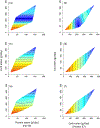The interaction of macronutrients and body composition among individuals with chronic spinal cord injury
- PMID: 35738897
- PMCID: PMC9789189
- DOI: 10.1017/S0007114522001830
The interaction of macronutrients and body composition among individuals with chronic spinal cord injury
Abstract
Changes in body composition and dietary intake occur following spinal cord injury (SCI). The Geometric Framework for Nutrition (GFN) is a tool that allows the examination of the complex relationships between multiple nutrition factors and health parameters within a single model. This study aimed to utilize the GFN to examine the associations between self-reported macronutrient intakes and body composition in persons with chronic SCI. Forty-eight individuals with chronic SCI were recruited. Participants completed and returned 3- or 5-day self-reported dietary recall sheets. Dietary intake of macronutrients (fats, proteins, and carbohydrates) were analysed. Anthropometric measures (circumferences), dual-energy x-ray absorptiometry (DXA), and magnetic resonance imaging (MRI) were used to assess whlole-body composition. Associations between all circumference measures and carbohydrates were observed. Among MRI measures, only significant associations between subcutaneous adipose tissue and protein x carbohydrate as well as carbohydrates alone were identified. Carbohydrates were negatively associated with several measures of fat mass as measured by DXA. Overall, carbohydrates appear to play an important role in body composition among individuals with SCI. Higher carbohydrate intake was associated with lower fat mass. Additional research is needed to determine how carbohydrate intake influences body composition and cardiometabolic health after SCI.
Keywords: Body composition; Carbohydrates; Geometric framework for nutrition; Macronutrients; Nutrition; Spinal cord injury.
Conflict of interest statement
The authors have no conflicts to report.
Figures




Similar articles
-
Frequency of Dietary Recalls, Nutritional Assessment, and Body Composition Assessment in Men With Chronic Spinal Cord Injury.Arch Phys Med Rehabil. 2015 Sep;96(9):1646-53. doi: 10.1016/j.apmr.2015.05.013. Epub 2015 Jun 3. Arch Phys Med Rehabil. 2015. PMID: 26047531
-
Influences of nutrition and adiposity on bone mineral density in individuals with chronic spinal cord injury: A cross-sectional, observational study.Bone Rep. 2015 Feb 18;2:26-31. doi: 10.1016/j.bonr.2015.02.002. eCollection 2015 Jun. Bone Rep. 2015. PMID: 28377950 Free PMC article.
-
Body Composition and Metabolic Assessment After Motor Complete Spinal Cord Injury: Development of a Clinically Relevant Equation to Estimate Body Fat.Top Spinal Cord Inj Rehabil. 2021;27(1):11-22. doi: 10.46292/sci20-00079. Top Spinal Cord Inj Rehabil. 2021. PMID: 33814880 Free PMC article.
-
Dietary Patterns and Growth, Size, Body Composition, and/or Risk of Overweight or Obesity: A Systematic Review [Internet].Alexandria (VA): USDA Nutrition Evidence Systematic Review; 2020 Jul. Alexandria (VA): USDA Nutrition Evidence Systematic Review; 2020 Jul. PMID: 35129906 Free Books & Documents. Review.
-
Dietetics After Spinal Cord Injury: Current Evidence and Future Perspectives.Top Spinal Cord Inj Rehabil. 2021;27(1):100-108. doi: 10.46292/sci20-00031. Top Spinal Cord Inj Rehabil. 2021. PMID: 33814888 Free PMC article. Review.
Cited by
-
Trends in measuring BMR and RMR after spinal cord injury: a comprehensive review.Br J Nutr. 2023 Nov 28;130(10):1720-1731. doi: 10.1017/S0007114523000831. Epub 2023 Apr 24. Br J Nutr. 2023. PMID: 37092679 Free PMC article. Review.
-
Nutritional alterations, adverse consequences, and comprehensive assessment in spinal cord injury: a review.Front Nutr. 2025 May 9;12:1576976. doi: 10.3389/fnut.2025.1576976. eCollection 2025. Front Nutr. 2025. PMID: 40416388 Free PMC article. Review.
-
Nutrition Education to Reduce Metabolic Dysfunction for Spinal Cord Injury: A Module-Based Nutrition Education Guide for Healthcare Providers and Consumers.J Pers Med. 2022 Dec 7;12(12):2029. doi: 10.3390/jpm12122029. J Pers Med. 2022. PMID: 36556250 Free PMC article. Review.
-
Nutrition and eating beliefs and behaviors among individuals with spinal cord injuries and disorders: Healthy or misconceived?Rehabil Psychol. 2025 Feb;70(1):1-14. doi: 10.1037/rep0000544. Epub 2024 Feb 15. Rehabil Psychol. 2025. PMID: 38358714 Free PMC article.
References
-
- Farkas GJ, Pitot MA, Berg AS, et al. (2019) Nutritional status in chronic spinal cord injury: a systematic review and meta-analysis. Spinal Cord 57, 3–17. - PubMed
-
- Bertoli S, Spadafranca A, Merati G, et al. (2008) Nutritional counselling in disabled people: effects on dietary patterns, body composition and cardiovascular risk factors. Eur J Phys Rehabil Med 44, 149–158. - PubMed
-
- Nightingale TE & Gorgey AS (2018) Predicting basal metabolic rate in men with motor complete spinal cord injury. Med Sci Sports Exerc 50, 1305–1312. - PubMed
Grants and funding
LinkOut - more resources
Full Text Sources

